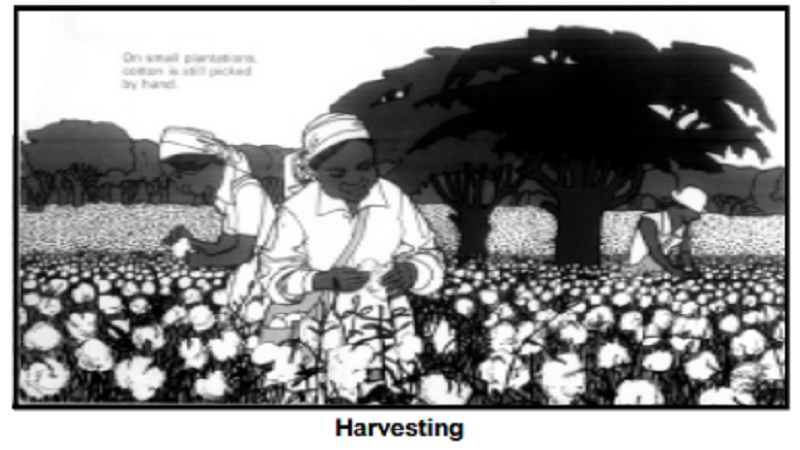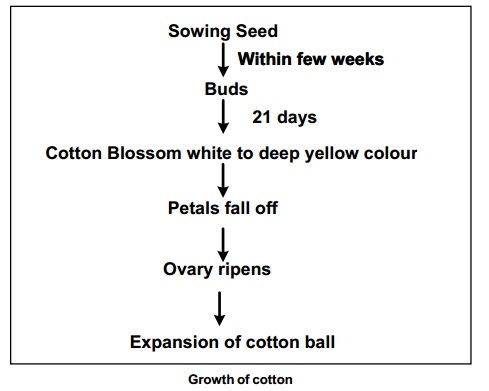Chapter: 11th 12th std standard Political Science History goverment rule laws life Higher secondary school College Notes
Cotton - Plant Fibers : History, Growth, Production, Utilisation

The source of Natural fibers are from plants, animals and mineral. Since these are
available naturally, it is called as natural fibers.
PLANT FIBERS:
Plant fibers are composed of cellulose and therefore are classified as natural cellulosic fibers. The important raw material to produce fabrics are fibers especially cotton and silk.
Cotton:
The word cotton is derived from the Arabic word qoton or qutun, which means a plant found in conquered land. Cotton is fiber that grows from the surrounding surface of seeds in the pods, or balls of a bushy mallow plant. It is composed basically of a substance called cellulose.
Principal Origin : Natural
Chemical Type :Cellulosic
Generic Name : Seed hair
Common Name :Cotton
a. History:
Cotton is still the fiber used mostly in the world.People around the world mostly use cotton as the main fiber. They prefer garment made from cotton than any other fibers. More over cotton is one of the best fiber suitable for our climate. The main raw material used for ccotton fabric is cotton pod. Ancient records shows that garments made out of cotton were used by Indians also.
Greek Philosophers refers that Indians were best in growing, spinning and weaving pure cotton fabric between 3000 BC-1500AD. Marco Polo on his voyage to our country states that the world's finest cotton fabrics were made from India. Cotton fabrics from India, are fine and of outstanding quality. Archeological findings at Mohenja-Daro suggest that the cotton plant was already domesticated and being used for making textiles over 5000 years ago.
b. Growth and Production:
Cotton is a member of the Mallow family. Its height ranges from 25 cm to over 2 m, depending upon variety, climate and agronomy. It is normally grown as an annual shrub.

(1) Preparation of Land:
The cleared land is ploughed and harrowed to breakup large lumps and remove ridges. Small furrows are opened and at the same time, the seeds are dropped in one at a time, generally with fertilizer being put in the furrow at the same time. Generally cotton is planted in February in the more southerly regions but it may be as late as June in the northernmost sections of the cotton belt. When the plants have grown to a height of 5 to 7 inches, they are generally thinned out so that there are not more than 2 or 3 plants per hill, or so that the plants are about 9 to 14' apart in rows. This is usually done by hand. Within a few weeks after the plant has emerged, the first buds appear. This consists of three triangular strapped leaflets or bracts, and the flower buds. It is at this stage when the plant is about to bear its blossom and seed, that it is most susceptible to insect damage. The principal enemy to cotton is the ball weevil. Other parts are aphids, worms, spider, mites and a number of other small insects.
(2) Maturing of the Ball:
About 21 days after the buds are first seen, the cotton blossom appears. This is at first a creamy white to a deep yellow color. Later it becomes pink and eventually dark red. It lasts about 3 days, after which the petals fall off and the ovary ripens to form a pod which we know as the cotton ball.
Next fibers push out from the coating of the seed, causing the ball to expand until it is nearly one inch in diameter and half again as long. Different varieties of cotton matures at different rates; usually it takes between 45 and 65 days from blossom to the open ball. The growing season, fertilizer, degree of cultivation and amount of moisture - all these factors may affect the maturing of cotton crops.
Sowing Seed -> Within few weeks -> Buds(21 days) -> Cotton Blossom white to deep yellow colour -> Petals fall off -> Ovary ripens -> Expansion of cotton ball
(3) Harvesting:
With the first frost, the cotton plant normally sheds its leaves, but the balls have matured and are opened often several weeks before the first frost. When the cotton crop is defoliated all the balls are more readily exposed to the sun, and the maturity is much more uniform.
Harvesting is either by hand or by picking machines.
(4) Ginning:
If the newly harvested seed cotton is wet, then it may have to be dried, using warm air, before it can be stored in large piles to await ginning. In many countries, drying is an integral part of the ginning process. 'Ginning' is the separation of fibers from the seeds. It is done by special machines. The separated fibers called lint, have a staple length of between 15 and 50 mm depending on the variety. On many types of seed, there are some very short fibers, called linters. They are made of cellulose and they find many uses, including the production of man-made fibers. The seeds can also be utilised for the production of edible oil.
100 kg of clean seed-cotton yields : 35 kg of fiber 62 kg seed 3 kg of waste
The lint passes on the conveyor belt to a bailing press, where it is compressed and packaged into the standard bales of 500 pounds in weight.

(5) Utilisation:
Cotton fibers are made into staple fiber yarns either by ring spinning or rotor spinning.
c. Properties of Cotton:
Lustre : Low
Tenacity / Strength : Medium
Elastic Recovery : Low
Elongation : 7%
Resiliency : low
Density : 1.54 g/cm3
Moisture absorption : 8.5%
Dimensional Stability : Good.
Acids : Damages, Weakens fiber
Alkalies : Resistant (mercerization)
Effect of sunlight : Weakens fiber slowly.
Insects : Silverfish damages fiber.
To flame : Burns readily.
Shape : Fairly uniform in width, 12 - 20 μ, length varies from � to 2� inches.
d. International Cotton Emblem:
This emblem serves clearly to identify textiles made from pure cotton and implies good quality. It may not be applied to fiber blends.
Related Topics